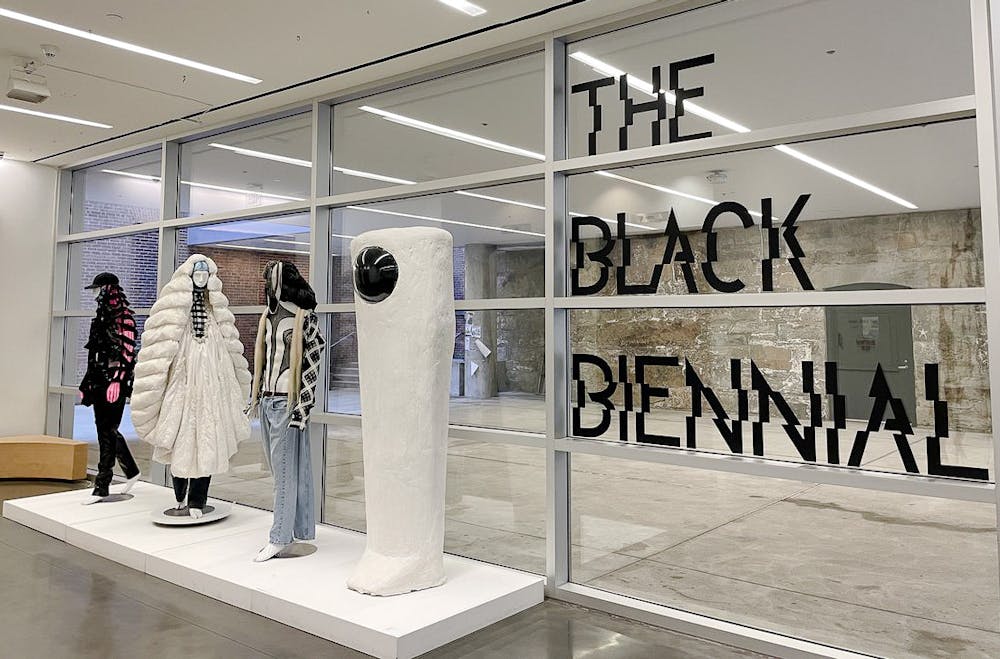After a month-long run at the RISD Museum’s Gelman Gallery, the inaugural Black Biennial exhibition is entering its closing weekend. Co-curated by Rey Londres, a RISD senior, and Melaine Ferdinand-King GS, the show features the works of over 80 Black artists from the Providence community and will remain on display until April 10.
“We were conscious of pretty tense relations between Providence community members and the students and faculty at institutions like Brown and RISD,” Ferdinand-King explained.
As a result, Ferdinand-King continued, she and Londres wanted to provide a space for community artists to highlight their work and experiences. “Given that Providence is known as a creative capital of the state, there’s a lot of history, especially as it pertains to Black and Indigenous artists, that we feel (needs) to come to light,” she said.
Londres and Ferdinand-King first conceptualized the project back in 2020, but the pandemic forced them to put the event on hold. Once museums and creative agencies opened back up, the pair was given the green light from RISD administrators and searched for funding, space and a team to support their project. They then put out an open call for artists and began the curatorial process.
Ferdinand-King and Londres guided the exhibition’s curation, each approaching the task from different angles due to their own distinct background experiences, Ferdinand-King said. While Londres works as a portraitist and photographer, Ferdinand-King studies political theory and aesthetics as a PhD student in the University’s Africana Studies department. Both she and Londres had done virtual exhibitions during the pandemic, but this was Ferdinand-King’s first physical installation.
“Rey, with an arts background, has a very traditional and more orthodox approach,” Ferdinand-King said. “He favored very technically strong artistic production, while I was very much interested in the more imaginative and radical aspects of what art potentially could be.”
Under the guiding theme of “new beginnings,” the team featured the works of artists ranging from Brown and RISD students to Providence community members without formal training to even formerly-incarcerated individuals, Ferdinand-King said.
“One thing that became a priority was not only the work itself and taking the work at face value, but also what was the story of the artists,” she added. “We wanted this to be a crafted expression of existence that considers the folks who aren’t normally considered deserving of taking space … we denied very few artists, and most of it was due to (spatial) limitation.”
Helping bring the co-curators’ vision to life were the project’s two design leads, Zoë Pulley and Jada Akoto, both RISD students, along with faculty advisor Shiraz Gallab, an assistant professor of graphic design at RISD.
“I joined the team in November of 2021 and essentially was working very closely with Jada to come up with the overall identity of the show,” Pulley said. She and Akoto worked together to build out the exhibition’s branding based on an early logo designed by Nailah Golden, another RISD graduate. The pair created the exhibition’s design collateral, including the web design, posters and merchandise, along with the labels and tags placed next to the art hung in the gallery, Pulley explained.
In addition, Akoto and Pulley also held an active role in designing the physical layout of the gallery, a process Pulley explained was informed by the project’s overall ethos of inclusivity.
“It was really important when we were working with Ray and Melaine (to figure out) how they envisioned pieces looking in the space,” Pulley said. “We were just making sure that all types of artists were represented as well as making sure that there were pieces that were close to one another that we felt were in conversation with each other.”
“As designers,” Akoto said, “we pretty much got free rein to do what we wanted in the space, which I think was really fun. We wanted to keep that emotion but also keep it very simple
The team hopes that the Biennial will run every other year, Ferdinand-King explained. In the off years, they are aiming to produce a catalog of the previous show’s works and artists which will serve as both a “process book and index,” according to Pulley.
“It felt like a blessing because we all came together by different means and ended up still all working really, really wonderfully together,” Pulley said. “We all came in knowing our skillset and running with that, putting it all on the table.”
While Ferdinand-King is still a fourth-year PhD student and will be able to see through future iterations of the exhibit, most of her colleagues will be graduating before the next showing planned for 2024, she said. “I’ll be spearheading the next Biennial, but with a new team—hopefully people who can take it on after I (leave) because I’m anticipated to graduate in 2024,” she added.
After multiple years of work on the project, Ferdinand-King considers the overwhelming support the exhibition received “the biggest triumph.”
“This was a dream that came to fruition … people came (to the exhibit) and said they really felt seen,” Ferdinand-King said. “Certain materials that are very familiar to the Black experience actually (were) given a spotlight in a way that other people haven’t seen or experienced before.”





